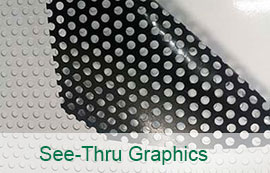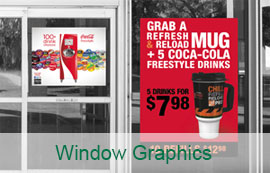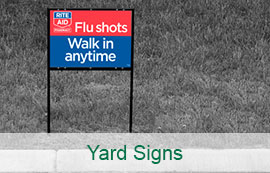TYPES OF OUTDOOR SIGNAGE
Outdoor signs can take a beating over time and no graphic has a bigger impact on your business than what is displayed outside drawing people in. Hopkins Printing is your ideal partner for large outdoor signage projects because we print with outdoor rated ink formulations designed to protect your graphics from the elements of UV light, weather, and abrasion.
While all of Hopkins products are printed with outdoor rated inks, it is important to let Hopkins know when your application needs long lasting outdoor durability so that Hopkins can make recommendations to meet your goals. Recommendations may include screen printing the job with special ink formulations, adding a UV ink clear coat, applying a protective over-laminate, or changing the substrate.
Hopkins prints directly onto the surface of all the commonly used outdoor rated materials ranging from corrugated plastics (Coroplast), pressure sensitive vinyl, expanded PVC (Sintra, Komatex), rigid vinyls, banners, magnetic materials, and smooth metals.
Why Use Outdoor Signage?
Outdoor signs are an integral part of a business and can be considered an extension of the business itself. Some of the many uses for outdoor signage include:
- Inform – give potential customers key information about your business.
- Create an impression – with well-designed signage, your business can attract customers with creative designs and call-to-actions.
- Promote – increase your foot traffic with outdoor signs promoting new sales and specials.
Custom Outdoor Sign Printing from Hopkins Printing
At Hopkins Printing, we want to make sure your business gets the attention it deserves. Our dedicated and experienced printers will work with you to create unique and compelling outdoor signage that will produce results. Our UV screen printing presses and ultra-high resolution UV digital printing presses can handle any size job, and we pride ourselves on bringing the highest quality to every project. It is this commitment to detail that sets Hopkins Printing above its competition.

Best Materials for Outdoor Signage
Placing outdoor business signage is a great way to attract attention, expand your brand awareness, and impress all passers-by. Regardless of how compelling your digital marketing campaigns are or how well-received your radio ad is, no advertising channel is as effective as the good old-fashioned outdoor sign. Without it, your business will miss out on significant foot traffic that generates revenue and cements your reputation.
When choosing your outdoor sign, the most important factor you’ll need to consider is the material. It will not only impact the visual experience but the sign’s durability, as well. So, let’s look at the most common outdoor signage materials and see which ones are the best.
Corrugated plastic
Corrugated plastic or Coroplast, is the most commonly used material for temporary signs promoting special events, sales, and unique offers. It’s lightweight, mobile, and affordable, giving you flexibility and full creative freedom to play with the design.
Expanded PVC
Expanded PVC goes under many names – Sintra, Komatex, and Celtec, to name but a few. Regardless of how you refer to it, it provides the perfect surface for printing for both indoor and outdoor use. Only the white substrate option is for outdoor applications.
It’s created from free foam PVC injected with air, which gives it extraordinary rigidity without the need for extra material. It’s inexpensive, durable, and boasts consistent coloring throughout.
Vinyl
Vinyl is the go-to material for banners and flags. It’s resistant and affordable, requiring virtually no maintenance and offering the utmost design flexibility.
Vinyl outdoor signage is commonly used for specific marketing campaigns, seasonal sales, and special promotions.
Smooth metals
Smooth metals like aluminum are incomparable to any other outdoor signage materials. They take color exceptionally well and allow you to print any design you want. They’re weather- and waterproof, strong, lightweight, and come in a variety of thicknesses. The life of the color is based on the ink as well as the material, so be sure to ask about life expectancy.
Although you’ll usually see aluminum used for outdoor signage on highways and roads, they’re perfect for any use – as A-frame sidewalk signs, mounted signs, and even H-frame signs.
Rigid vinyl
No other material boasts such versatility as rigid vinyl. Depending on its thickness, it can be used as a decal or floor graphic or as outdoor signage that withstands all wear and tear. It’s resistant to cracking and curling and retains color thanks to its high UV resistance levels.
Indoor Signage vs. Outdoor Signage
Indoor and outdoor signs serve entirely different purposes.
On the one hand, outdoor signs are designed to demand attention and draw in as many random passers-by as possible. They’re bold, bright, and flashy with the purpose of attracting foot traffic.
On the other hand, indoor signs are designed to inform and engage audiences. They’re used as navigation throughout your store and as product highlights. Their goal is to encourage shoppers to make a purchase.
Different target audiences
Considering the differing purposes, it should come as no surprise that indoor and outdoor signs have vastly different audiences.
Outdoor signs should speak to a broader audience – those already interested in your business and those who have no idea who you are and what you do. They should be clear, concise, and informative, sparking the interest of everyone who sees them.
On the flip side, indoor signs should target the customers who are already interested in your business. They should be persuasive and educational, providing your leads with a gentle nudge to make a purchase. They shouldn’t be as flashy or overly promotional as outdoor signs.
Indoor vs. outdoor signs’ materials
Indoor signs need to be made of high-quality materials that improve the visual experience and add to the overall atmosphere of your space. They should be durable, lightweight, and attractive, since they will be seen from up close and possibly touched which means using materials such as rigid vinyl, high-impact polystyrene, or expanded PVC.
Outdoor signs, on the other hand, need to be resilient and durable. Since they have to withstand the elements, they need to be waterproof and resistant to UV and wear and tear. The best materials for outdoor signage include Coroplast, banners, decal vinyl, white expanded PVC, and aluminum.
Contact us today for any variety of outdoor signage products!













